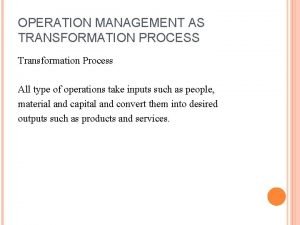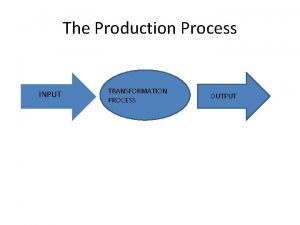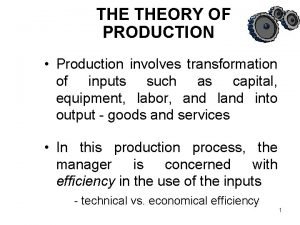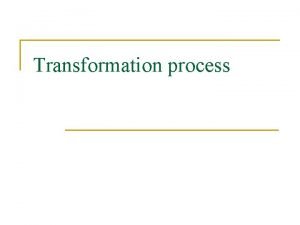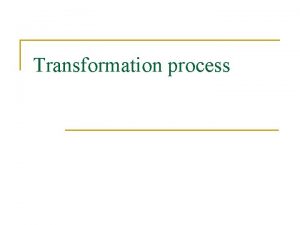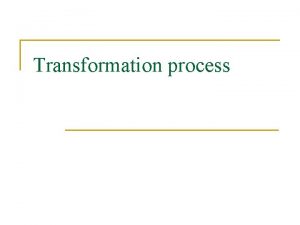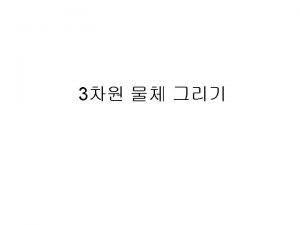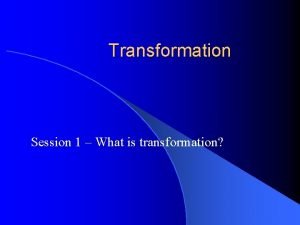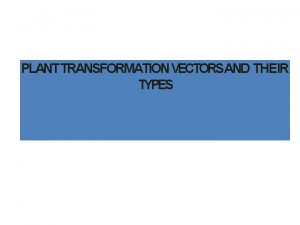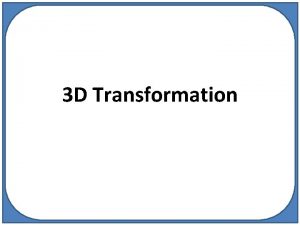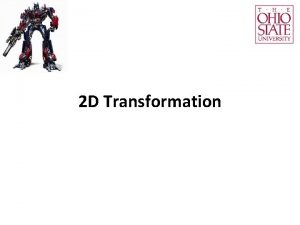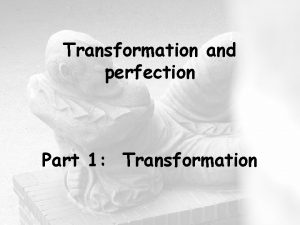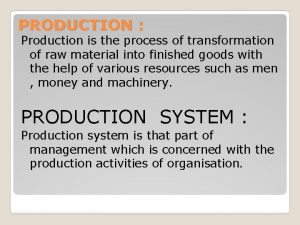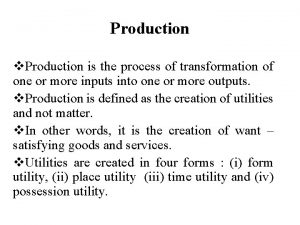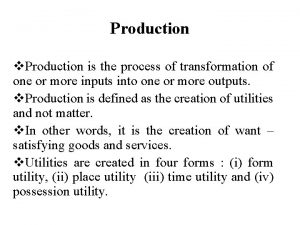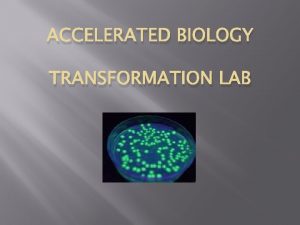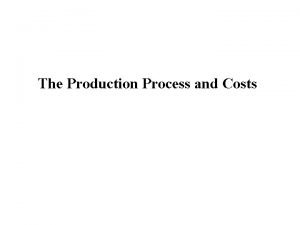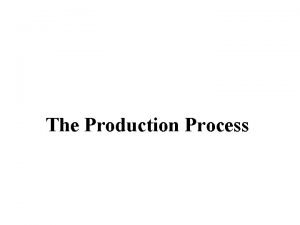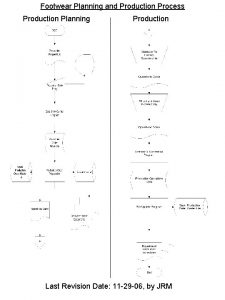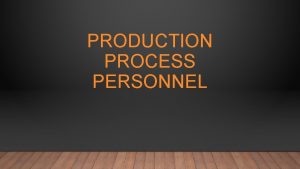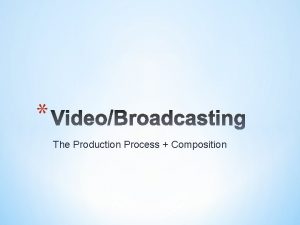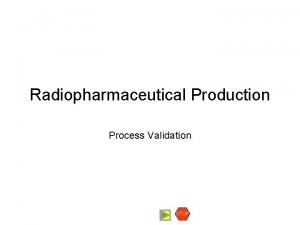Production v Production is the process of transformation
































- Slides: 32

Production v. Production is the process of transformation of one or more inputs into one or more outputs. v. Production is defined as the creation of utilities and not matter. v. In other words, it is the creation of want – satisfying goods and services. v. Utilities are created in four forms : (i) form utility, (ii) place utility (iii) time utility and (iv) possession utility.

v. A good may be transformed by changing its physical form (form utility), transporting it to another place (place utility) or being kept in store unit required (time utility). v. Production essentially means transformation of one or more inputs into one or more outputs or one set of goods into another set of goods. v. Gifts of nature are utilised by man in satisfying his wants and production is not complete unless the product reaches the consumer).

Factors of production v. Land, Labour, Capital and Organisation are the four factors of production. These are required in almost every production process. These are used as basic ‘inputs’. v. These four essential inputs needed to undertake production are called factors of production. v. The factors of production have a price. They are not free goods and one has to pay for them. The payments made for the use of the four factors of production are known as rewards.

Reward for factors of production Factor Land Labour Capital Management Reward Rent Wage Interest Profit

Characteristics of factors of production v. The four factors of production have some specific features which influence their use in production. v. The law of variable proportions, the returns to scale and the isoquants are all based on these features of factors of production.

Substitutability v One factor of production, say labour, may be substituted for another factor, say capital. Complementarity v. The use of one factor may cause of another factor. For example, when more labour is used, more capital may be needed.

Specificity v. A factor is said to be specific when it can be used for one purpose only. Spare parts of a machine, for example, may be specific for that machine only. Versatility When a factor could be used for all purposes, it is said to be versatile. However, in practice, some factors may not be completely versatile. Such factors with low versatility are called specialised factors.

Law of diminishing returns v This law is perhaps one of the oldest laws of economics. v. The classical economists thought it applied principally to agriculture. v. Alfred Marshall defined the law of diminishing returns as follows:

v“An increase in the capital and labour supplied to the cultivation of land causes, in general, a less than proportionate increase in the amount of produce raised, unless it happens to coincide with an improvement in the arts of agriculture”. v. In agriculture, the marginal returns decrease successively. Marginal returns means additional returns. v. Since the marginal returns decrease successively, this law is called as law of diminishing marginal returns.

The law has two limitations: 1) It is assumed that there is no improvement in the technology of production 2) The land quality is known fully and it is utilized fully.

v. Modern economists classify factors involved in production as fixed and variable factors in the short-rum. v. When the factors are combined in variable proportions, this law operates and hence it is called as law of variable proportions. v. When the level of use of inputs increases the cost incurred also increases. v. Therefore, this law is also known as law of increasing costs.

Causes of the law v Among the causes which operate the law of diminishing marginal returns three are important: (i) the supply of factors of production is not perfectly elastic; (ii) the factors are not perfect substitutes for one another and (iii) diseconomies of scale set in when the firms become big.

Limitations of the law v This law does not operate in the initial stages of production. Also, when the technology changes or improved technology is adopted, this law ceases to operate

Three regions of the law v Production has three stages as shown in Figure 5. It shows how the Total Product (TP), Average Product (AP) and Marginal Product (MP) change due to the increase of a variable factor (labour) on the output.

Region I v It is the region between point of origin to the point where the marginal products is greater than average product. v. In this region, the total product (TP) increases first at an increasing rate but later at a decreasing rate. v. This point where the rate of increase in total product is from an increasing rate to a decreasing rate occurs , is called point of inflexion.

v. The marginal product is at its maximum. v. In this region the total product, average product and marginal product increase and hence it is called ‘increasing returns stage’. v. It is an irrational production region. v. The average product continues to increase and where the marginal product equals average product, the stage I region ends.

Region II v. The region between region I and the point where marginal products becomes zero is called region II. v. The total product continues to increase but at a diminishing rate and finally it stops increasing any further. v. Similarly, the average and marginal products also decrease and are positive.

v. The total product is at its maximum and marginal product is zero. v. In fact, the marginal product curve cuts the Xaxis in this region. v. The second region is called the ‘stage of diminishing returns’. v. This is the rational production region in which it is most profitable to operate.

Region III v. In this region, the marginal product turns negative. v. The total and average products decrease. v. This region is called the ‘negative returns region’. v. It is yet another irrational production region.


From the Figure – 5, we could see that: (i) When the marginal product is greater than average product, the average product is increasing; (ii) When marginal product is less than average product, the average product is decreasing; and (iii) When the marginal product equals average product, the average product is at its maximum.

Resource Scarcity v. We had already seen that human wants are unlimited and reoccurring. v. But the resources which are needed to satisfy these wants are rather limited. v. Further, the resources have alternative uses also. v. Therefore, use of these scarce resources is essentially a question of choice.

v. Once the option is exercised, the next choice is forgone. v. Resource scarcity is the central theme of economics as it attempts to portray human behavior in using scarce resources having alternative uses to satisfy unlimited and reoccurring human wants. v. To produce a good we need four basic requirements: land, labour, capital and management. These are called the factors of production.

v. These are called the factors of production. v. These are otherwise essential or inevitable inputs. v. These resources are also scarce and have alternative uses. It means judicious decision making is needed to make the best use of these resources.

Production Relationships A production process , before it begins needs to answer the following basic questions: 1) What to produce? (Product-Product relationship) 2) How to produce? (Factor-Factor relationship) 3) How much to produce? (Factor-product relationship)

Product-product Relationship v. A producer is considered as a profit maximize as he or she always aims to make more profits. v. So profit maximization should be his or her goal. v. Since, resources are scarce and have alternative uses, he or she needs to know the best possible combination of enterprises, either one enterprise or an appropriate combination of more than one enterprise, to achieve this goal.

v. In order to decide on the choice of enterprises, the biophysical relationship between the enterprises, product prices and the resource base available are to be considered. v. The principle of substitution of products would help in this regard.

Factor-Factor Relationship v. A producer may have to use one or more inputs to produce one or more outputs. v. It is not only the right kinds of inputs but also their optimum level of use which will help to minimize the cost of production without compromising on the level of output.

v. Factor-Factor relationship is typically a question of identifying the optimum or leastcost combination of resources to produce a certain amount of output. v. Minimisation of cost of production depends on the cost of inputs, price of outputs and on the marginal rate of substitution of factors.

v. Isoquant or Iso-product curves show all possible combination of two inputs which would yield the same level of output. v. Similarly Isoquants may be traced for different levels of output.

Factor-product relationship v. Production is the transformation of one or more inputs into one or more outputs. v. Production function shows the functional relationship between the inputs used and output obtained. v. A production function may be specified as follows

Y=output of farmed fish in kg/ha X 1=time used in kg/ha X 2 =Manure used in kg/ha X 3=Fertilizer used in kg/ha X 4=Seed or fingerlings in Nos/ha X 5=Feed used in kg/ha X 6=power in units consumed. v. The classical production curve shows that production region II alone is rational and the other regions, I & III are irrational
 Proses pre production
Proses pre production The transformation process in operations management
The transformation process in operations management Is the human input into the production process
Is the human input into the production process 3 stages of production
3 stages of production Hình ảnh bộ gõ cơ thể búng tay
Hình ảnh bộ gõ cơ thể búng tay Lp html
Lp html Bổ thể
Bổ thể Tỉ lệ cơ thể trẻ em
Tỉ lệ cơ thể trẻ em Gấu đi như thế nào
Gấu đi như thế nào Chụp tư thế worms-breton
Chụp tư thế worms-breton Alleluia hat len nguoi oi
Alleluia hat len nguoi oi Kể tên các môn thể thao
Kể tên các môn thể thao Thế nào là hệ số cao nhất
Thế nào là hệ số cao nhất Các châu lục và đại dương trên thế giới
Các châu lục và đại dương trên thế giới Công thức tính độ biến thiên đông lượng
Công thức tính độ biến thiên đông lượng Trời xanh đây là của chúng ta thể thơ
Trời xanh đây là của chúng ta thể thơ Mật thư anh em như thể tay chân
Mật thư anh em như thể tay chân Phép trừ bù
Phép trừ bù độ dài liên kết
độ dài liên kết Các châu lục và đại dương trên thế giới
Các châu lục và đại dương trên thế giới Thể thơ truyền thống
Thể thơ truyền thống Quá trình desamine hóa có thể tạo ra
Quá trình desamine hóa có thể tạo ra Một số thể thơ truyền thống
Một số thể thơ truyền thống Cái miệng xinh xinh thế chỉ nói điều hay thôi
Cái miệng xinh xinh thế chỉ nói điều hay thôi Vẽ hình chiếu vuông góc của vật thể sau
Vẽ hình chiếu vuông góc của vật thể sau Nguyên nhân của sự mỏi cơ sinh 8
Nguyên nhân của sự mỏi cơ sinh 8 đặc điểm cơ thể của người tối cổ
đặc điểm cơ thể của người tối cổ Thế nào là giọng cùng tên?
Thế nào là giọng cùng tên? Vẽ hình chiếu đứng bằng cạnh của vật thể
Vẽ hình chiếu đứng bằng cạnh của vật thể Phối cảnh
Phối cảnh Thẻ vin
Thẻ vin đại từ thay thế
đại từ thay thế điện thế nghỉ
điện thế nghỉ

